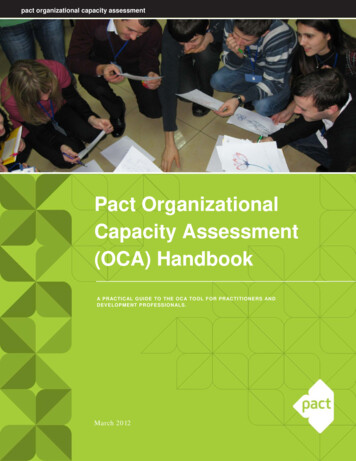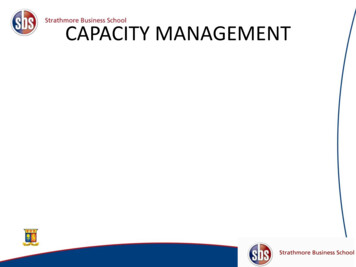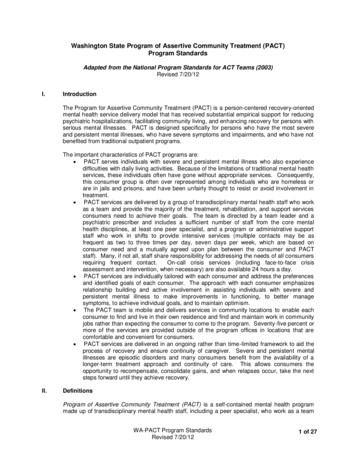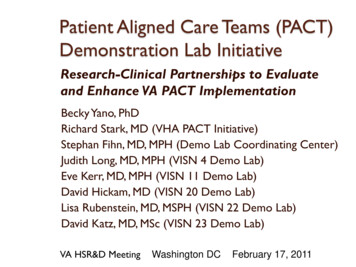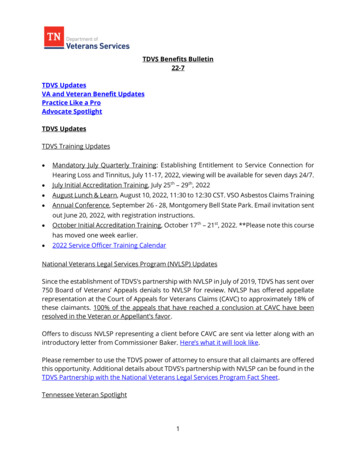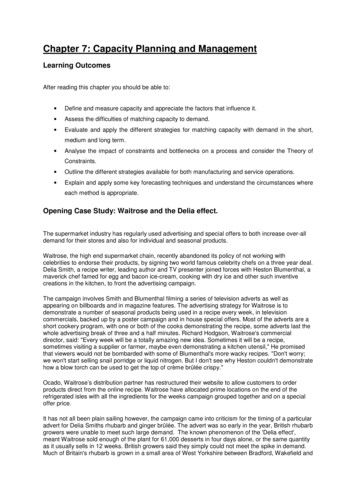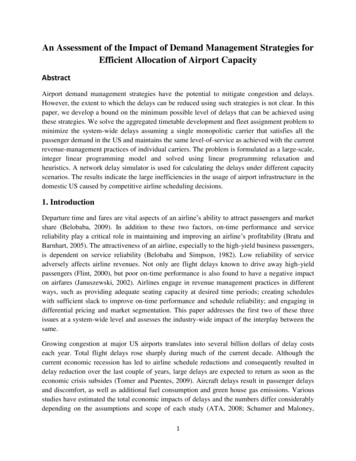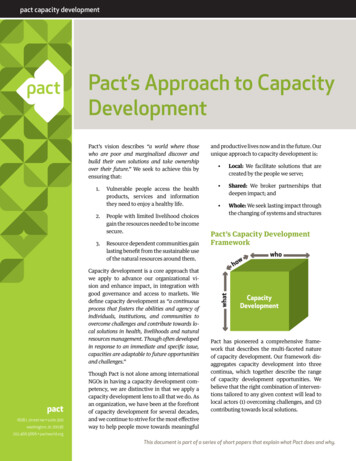
Transcription
pact capacity developmentPact’s Approach to CapacityDevelopment1.2.3.Vulnerable people access the healthproducts, services and informationthey need to enjoy a healthy life.People with limited livelihood choicesgain the resources needed to be incomesecure.Resource dependent communities gainlasting benefit from the sustainable useof the natural resources around them.Capacity development is a core approach thatwe apply to advance our organizational vision and enhance impact, in integration withgood governance and access to markets. Wedefine capacity development as “a continuousprocess that fosters the abilities and agency ofindividuals, institutions, and communities toovercome challenges and contribute towards local solutions in health, livelihoods and naturalresources management. Though often developedin response to an immediate and specific issue,capacities are adaptable to future opportunitiesand challenges.”pact1828 L street nw suite 300washington, dc 20036Though Pact is not alone among internationalNGOs in having a capacity development competency, we are distinctive in that we apply acapacity development lens to all that we do. Asan organization, we have been at the forefrontof capacity development for several decades,and we continue to strive for the most effectiveway to help people move towards meaningfuland productive lives now and in the future. Ourunique approach to capacity development is: Local: We facilitate solutions that arecreated by the people we serve; Shared: We broker partnerships thatdeepen impact; and Whole: We seek lasting impact throughthe changing of systems and structuresPact’s Capacity DevelopmentFrameworkwhowhatPact’s vision describes “a world where thosewho are poor and marginalized discover andbuild their own solutions and take ownershipover their future.” We seek to achieve this byensuring that:whoCapacityDevelopmentPact has pioneered a comprehensive framework that describes the multi-faceted natureof capacity development. Our framework disaggregates capacity development into threecontinua, which together describe the rangeof capacity development opportunities. Webelieve that the right combination of interventions tailored to any given context will lead tolocal actors (1) overcoming challenges, and (2)contributing towards local solutions.202.466.5666 pactworld.orgThis document is part of a series of short papers that explain what Pact does and why.
pact capacity developmentWhose Capacity Are We Developing?INDIVIDUALORGANIZATIONNETWORKSYSTEMThe first continuum of Pact’s capacity development framework describes the range of actors weengage with for capacity development support, or “whose capacity is being developed?” Individuals such as civil society leaders, youth activists, change agents or developmentprofessionals. Organizations include civil society organizations, for-profit businesses and government departments. Networks include civil society networks, coordinating bodies at the local or national level,business coalitions and communities of practice. Systems are groups such as communities and national or regional groups of actors responding to a common issue.In order to develop the most powerful local solutions, it is necessary to identify targets for capacitydevelopment that have the greatest potential to generate positive impact.What Capacity Are We INGThe second facet of Pact’s capacity development framework describes the range of capacities thatwe are seeking to develop through our support, or “what capacities are being developed?”Technical Capacities are the capacities relevant to the specific impact area or developmentchallenge that the actor is seeking to address. Technical capacities may be those related todelivering services to most vulnerable children, managing an ecosystem,developing small and medium sized enterprises, etc.In Ethiopia a comprehensive ex Organizational Capacities are the skills and abilities necessary to impleternal 10 Year analysis of our workment individual tasks in a consistent and reliable way. Such capacities inin organizational capacity develclude systems and structures for organizational governance, financial manopment concluded that Pact’s apagement, human capital development, resource mobilization, etc.proach to capacity development allowed partner organizations to gain Adaptive Capacities focus on the ability to react to changes in operatingconfidence, establish a track recordenvironment whether due to political, environmental or socio-cultural reaof program implementation and acsons. Critical skills for adaptation include the ability to plan, analyze andcess new resources. Furthermore,learn.our work fostering social capital Influencing Capacities are those skills that enable actors to alter the envibetween government officials andronment in which it operates. Examples include improved advocacy, lobbycivil society leaders resulted in iming, negotiation and research skills.proved relationships between thegovernment and the NGO sectorThe most powerful capacity development interventions, those most likely to supwhich directly impacted the policyport real change, work on strengthening partner capacities across the whole conenvironment.tinuum. 2
pactworld.orgHow Are We Developing Capacity?CONSULTANCYSERVICESTRAININGMENTORING &COACHINGKNOWLEDGEMGMTPEEREXCHANGE &LEARNINGThe third facet of Pact’s capacity development framework describes the range of methodologies forcapacity development interventions, or “how is capacity being developed?” Capacity developmentinterventions vary from being highly expert-driven to highly participant-driven. Consultancy services and trainings deliver expert knowledge and best practices to our partners. Mentoring and coaching and knowledge management techniques support the embeddingof new capacities within partners. Peer exchange activities allow partners to learn from successes and challenges of others.Pact’s recommends an approach that draws upon multiple methodologies and learning styles, customizing these to the partner organization and the particular challenge at hand.Principles of Good Capacity Development?Underpinning all of Pact’s capacity development work are four key principles. Pact’s Principles ofGood Capacity Development were initially developed as part of Pact Ethiopia’s comprehensive capacity development evaluation in 2008. They were revised in 2011 by members of Pact’s CapacityDevelopment Community of Practice. The principles draw heavily on a diverse literature base andhave since been applied to our projects worldwide.1.Quality: Pact employs and nurtures highly qualified personnel to develop practical skillsand competencies of partners, so that they can improve performance, develop local solutions, enhance impact and achieve development goals. Approaches are researched, tested,documented and packaged, and this is coupled withtraining of staff for effective scale-up.2.Partnership: Pact creates trust-based relationshipswith partners where capacity development is facilitated for mutually agreed results. Capacity developmentneeds are determined jointly with partners/clientswho actively engage in and own the process. Pact intentionally links partners for networking, mentoring,information sharing and joint stomization: Capacity development responsesare tailored to the specific values, challenges and opportunities of organizations within the context that they work. Interventions are designedbased on the results of participatory assessments and on-going monitoring of progress.4.Learning: Capacity development includes a deliberate process of reflecting on the interventions and results to better respond to organizational challenges and adapt to change.Continuous learning is baked into programming as both a process and result of capacitydevelopment.Pact’s recommends an approach that draws upon multiple methodologies and learning styles, customizing these to the partner organization and the particular challenge at hand.3
pact capacity developmentPhases of a Pact Capacity Development InterventionThere are five core phases of any Pact capacity development intervention.Phases of Capacity DevelopmentScanAnalyzePlanActLearnScan — The first phase of a Pact capacity development intervention is a scan of the ecosystem ofactors – the individuals, organizations, networks and systems – that have the potential to eitherpositively or negatively influence the development challenge that we are seeking to address.In order to achieve success, it is necessary to identify those actors that are in the best position toinfluence the development challenge at hand. These actors will be the focus of Pact’s capacity development support over the life of an initiative. Traditionally, capacity development efforts havefocused at the individual and organizational levels. Increasingly, however, Pact’s capacity development practitioners are recognizing the importance of directly supporting networks and systems inorder to bring multiple competencies to bear against complex challenges.Pact has a range of tools that support the scan phase of a capacity developmentintervention. These include: Organizational Network Analysis (ONA); SectoralAnalyses; Stakeholder Mapping; Good Governance Barometer (GGB); and AnnualProgram Statements (APS)Analyze — The specific support provided to any given actor is determined througha comprehensive, holistic capacity analysis. Our capacity analysis tools are tailoredto the specific context and development challenge, but take into account a full continuum of technical, organizational, adaptive and influencing capacities that weknow to be critical for success.Pact’s capacity analysis tools are built around the principles of quality, partnership,customization and learning. As such our capacity development initiatives employguided self-assessments whereby our partners assess themselves with the assistance of trained Pact facilitators and clearly articulated capacity benchmarks.In the LAAR program in Cambodia,Pact worked to develop planningand strategic capacities within 365commune councils. Independentevaluators compared Pact commune councils with a comparisongroup that had not received capacity development support and foundthat Pact councils were “more conscious about participation and accountability, more aware of socialissues, and more confident theycan serve citizens and deal with officials and NGOs.”Pact has a range of tools that support the analyze phase of a capacity developmentintervention: Organizational Capacity Assessments (OCA); Programmatic CapacityAssessment (PCAT); Technical Organizational Capacity Assessments (TOCA); Rapid Organizational Scans (ROS); Network Capacity Assessment (NECA); and Organizational NetworkAnalysis (ONA). Managers are encouraged to select the analysis tool(s) that are most relevant for theneeds of their partners.Plan — The results of capacity analyses are shared with our partners and used to inform the development of a plan for capacity development. A partner’s capacity development plan identifiesthe needs that an organization is seeking to address over 1-3 years. It identifies the steps that willbe taken to develop capacity over time, and the anticipated results from the completion of those4
pactworld.orgIn South Africa, an independentanalysis of our capacity development program emphasized the success of grant-making as a capacitydevelopment tool. Evaluators concluded that Pact Capacity Development efforts had resulted in a 9fold increase in the scale of HIV/AIDS service delivery and a 400%increase in the absorption capacityof partners over a five year periodof the project. At the same time,the evaluation found that “nearly allgrantees consistently achieved orexceeded key program quality targets set by USG and [South African]government.”steps. Furthermore it identifies the different roles to be played and responsibilitiesheld by the partner, Pact and other actors in supporting this capacity development.As capacity development support is a partnership, there should always be a balancebetween the responsibilities of Pact and the responsibilities of the partner.The specific contents of a partner’s capacity development plan are identified andnegotiated between Pact and the partner organization. The completed plan belongs to the partner who is the owner of the plan and may use the plan in supportof negotiations with other donors or partners. Performance based incentives maybe linked to the completion of activities in a capacity development plan. Where apartner shows greater commitment towards completing their own commitments,in turn they unlock additional external support to their efforts.Pact’s primary tool for the plan phase of a capacity assessment is the CapacityDevelopment Plan (CD Plan), Institutional Strengthening Plan (ISP) or NetworkStrengthening Plan (NS Plan). These tools share common elements, but are tailoredto the country context and development challenge.Act — Capacity development interventions vary from being highly expert-driven consultancy services or trainings, to highly participant-driven peer-to-peer exchange. Pact’s distinctive approachemphasizes the use of a range of techniques to best support the development of skills, abilities,processes and practices in the systems, communities and organizations with which we work.Our experience in multiple contexts, and with diverse actors has taught us that one-off trainingsare never enough to fully develop a new capacity, and that we can significantly increase uptake ofnew skills by combining training with follow-up assistance, access to relevant intellectual capitaland opportunities for peer learning. All Pact capacity development initiatives are designed with thisbest practice in mind.Pact has a range of tools and approaches that support the act phase of a capacity development intervention: Capacity Development Toolkit; Network Strengthening Toolkit; Capacity DevelopmentMarketplace; and Grants Management Toolkit.Learn — Pact’s comprehensive approach to monitoring and evaluation capacity development supports our local partners to analyze, learn from, and improve upon their activities to deliver betterimpact. For this reason, Pact has developed a series of curricula designed to help local organizationsbuild their own M&E systems. All courses focus on learning by doing, in order that so participantsare empowered to apply principles and practices to the creation of M&E systems for their own organization. Curricula include: Building Basic M&E Systems; Field Guide to Data Quality; Evaluationfor Program Managers; and M&E for ME.Measuring Capacity Development?Pact’s theory of change for capacity development can be described as follows: (a) Stronger local organizations and networks (b) do better work and, (c) as a result, have greater impact (on health, theenvironment and livelihoods) in their target communities. In order to know whether our capacitydevelopment activities are succeeding, we need to measure three things:5
pact capacity developmentOutputsChange in the internalpolicies, procedures andpractices of individuals,organizations, networksand systemsOutcomesImproved performance ofindividuals, organizations,networks and systemsImpactImproved health,environment and/orlivelihoods in thecommunities served byindividuals, organizations,networks and systems1.Change in the internal policies, procedures and practices of a partner: These internalchanges map to the “outputs” in our conceptual framework. They include improved financial systems, governance policies, HR procedures, leadership, communication, projectmanagement, and technical standards. Pact has a number of tools that we use to measurethis change, including our Organizational Capacity Assessment (OCA), Network CapacityAssessment (NECA), Technical Organizational Capacity Assessment (TOCA) and Organizational Development Roadmap.2.Change in partner performance: These external changes map to the outcomes of capacitydevelopment in our conceptual framework. Pact breaks down performance into four key areas developed out of IDRC/Universalia’s capacity development framework: Effectiveness – Partners are better able to achieve the outcomes theyset for themselves and consistently achieve higher standards of service. Efficiency – Partners are able to reach more people and complete activities on-time and on-budget. Relevance – Services meet the continuum of care needs of beneficiaries and communities and are not duplicative of others. Sustainability – Partners are financially sound. Services and activitiesdesigned/implemented in such a way that they can continue whileneeded.In Myanmar, Pact works to buildthe capacity of individual changeagents or ‘community health champions.’ A recent external evaluationagainst a comparison group foundthat “tuberculosis case detectionrates are two times higher in Pactsupported villages than neighboring villages.”Improved performance is evidenced through progress across each of these areas, which ismeasured using the Organizational Performance Index.3.Change in the health, livelihoods and/or national resource management of communitiesserved by partners. Community level changes in health, natural resources managementand livelihoods are the impact of our capacity development initiatives, the change that Pactand our partners seek to bring achieve. Progress towards these changes is predominantlymeasured through evaluations of our projects and initiatives.6
pactworld.orgResources for Capacity DevelopmentThe following links contain a wealth of resources for capacity development practitioners: Pact’s Capacity Development Community of Practice Intranet Site lt.aspx): Includes modules of Pact’s Capacity DevelopmentToolkit, materials collected from Pact country offices and organized by topic area and issuesof the Capacity Courier newsletter. “Capacity Development in Practice” Book (available free on line at: nt.aspx): Compendium drawn together from the workof several capacity development thought leaders was published in 2010 and describes thestate of the art of the field. AIDSTAR II (http://www.aidstar-two.org/): Learning portal containing an array of resourcesfrom multiple organizations around capacity development for HIV/AIDS. Learning Network for Capacity Development (www.lencd.org): Active online communitymoderated by the World Bank Institute and UN Capacity Development Group. Capacity.Org (www.capacity.org): Portal sponsored by SNV, produces a quarterly magazinefocusing on a particular aspect of capacity development. ECDPM Capacity Change and Performance (http://www.ecdpm.org/Web 2573FB0054BEDB?OpenDocument): Materials from a five year study into capacity development from 2003-2008.This work is licensed under the Creative Commons Attribution-ShareAlike 3.0 UnportedLicense.To view a copy of this license, visit http://creativecommons.org/licenses/by-sa/3.0/or send a letter to Creative Commons, 444 Castro Street, Suite 900, Mountain View,California, 94041, USA.7
Consultancyservices and trainings deliver expert knowledge and best practices to our part - ners. Mentoring and coaching and knowledge management techniques support the embedding of new capacities within partners. Peer exchange activities allow partners to learn from successes and challenges of others. Pact's recommends an approach that draws upon multiple methodologies and .

